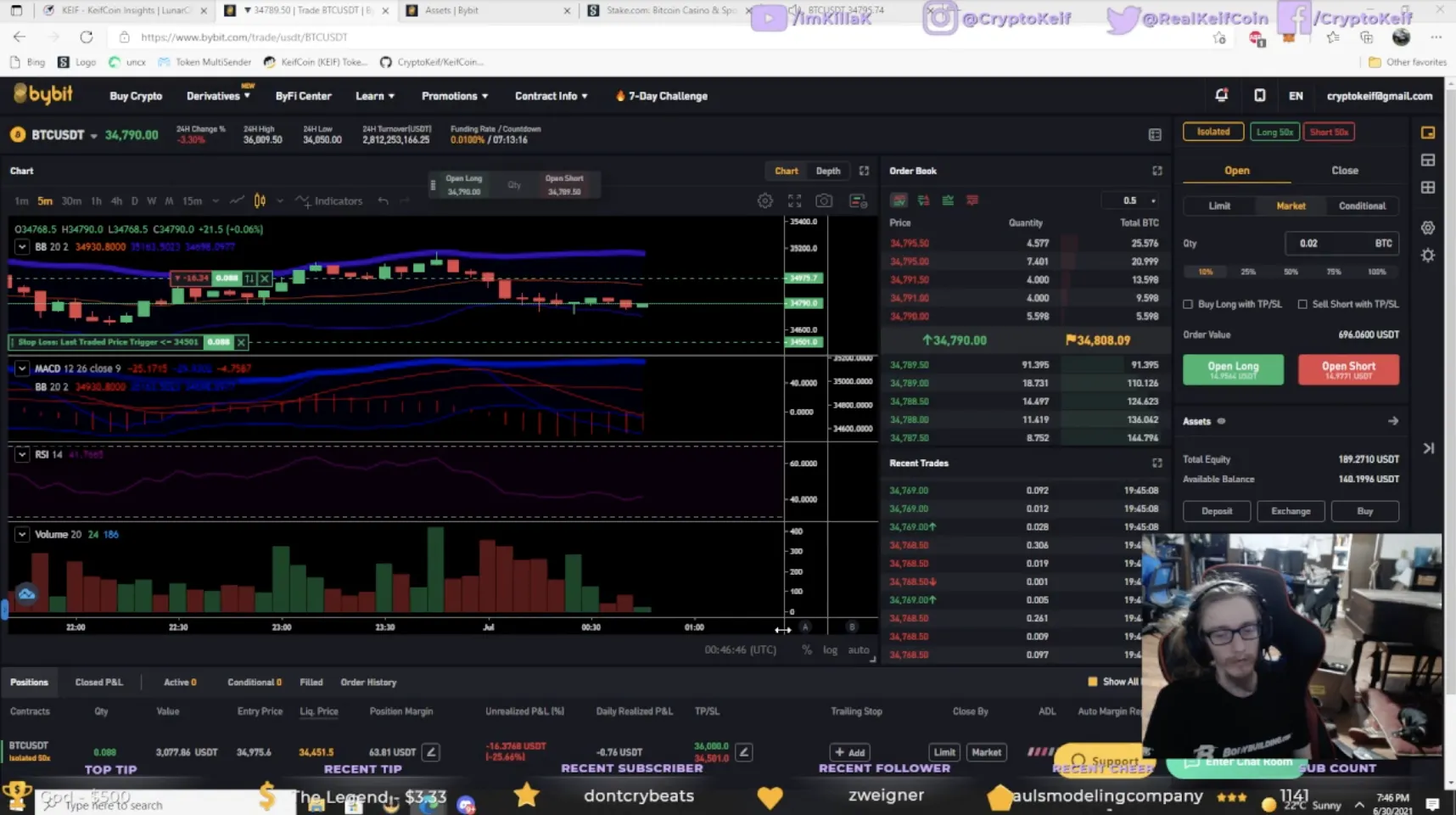
Keifer Atwood, a 27-year-old living in Jacksonville, Arkansas, estimates he’s lost millions on spectacularly bad crypto trades in the past few years. Over the past month alone, he claims he lost close to $80,000 dollars—“my life savings.”
But chin up! It’s good for business: Atwood has figured out a way to make a modest living by broadcasting these crypto-trading train wrecks to nearly 12,000 appreciative fans on his Twitch livestreaming channel, Crypto Keif.
“Are you saying that I’m liquidated? Oh my gawd, that was a accident, what the fuck!” drawls our hero in one of his more celebrated videos. In that one, Atwood manages to accidentally place a large order on Bitcoin futures—at the very moment the crypto takes a painful nosedive. It’s comedy gold.
“Wait—whaaaat? I did put a’ order?” he exclaims, baffled.

In another clip, Atwood places a long position instead of a short position, and, again, is liquidated like the bowels of a Pomeranian evacuating a half-chewed squirrel.
Since Atwood’s losses began to seriously compound, followers have begun flocking to his Twitch channel to watch him make a mess of things. He’s even got a sponsor out of his misfortune, a “Bitcoin casino” that perceives value in affiliating with this guy.
Weirdly, watching crypto traders lose money, live, seems to be a genre that includes a few other streamers such as Cobielive and Doctor Degen. (His Twitch bio: “I'm Doctor_Degen (John) started gaming back in 2018 to help deal with depression. Since then I've managed to die 1000s of times online which has brought nothing but real-world happiness!”)
Though Atwood et freres might seem to be a stark warning against risk-free crypto trading, to me they are the embodiment of that more ennobled form of crypto enthusiast—the self-effacing, openly degenerate trader. Atwood especially, with his thick, rectangular spectacles and messianically long hair, is a far cry from the loafer-wearing gargoyles of the industry mainstage. The sense that he is genuinely not doing well off of this makes him refreshingly authentic—a hard thing to come by in this sordid world of grotesque shills and counterfeit bills!
What also interested me was Atwood’s somewhat more ominous decision in the wake of all the publicity to mint his own crypto token, “KeifCoin.” It seems to have been mostly created as a way to recoup past losses and has already caused some consternation among its “investors.”
“It went crazy this past week,” he told me, earlier this month. “Now I just been working all week on this coin, I’ve been trying to do everything I can to make it work.”
Keif's grim beginnings
Atwood told me he began his amusingly unlucky “career” around 2013, when he started mining bitcoin but abandoned it just before doing so became lucrative. Then he invested in Bitcoin and held it for years, made a little money, but was unfortunate enough to sell his holdings just before the 2017 surge. Had he not sold, he said, he would have made around $3 million.
Next he made a seemingly disastrous move, from holding unsuccessfully to trading unsuccessfully. Scroll down to see how well that lil’ gambit turned out, eh?

Entering the exciting world of leverage trading
But making a silk purse out of a pig’s ear, he decided to stream his adventures in trading, live, to a few loyal followers on Twitch. The real entertainment value came when, after his fortunes dwindled from $250,000 to $100,000, Atwood decided to enter the exciting world of leverage trading, which of course, he knew nothing about, he readily admits.
Leverage trading, as just about everyone else knows, is an extraordinarily risky way to make a buck. It basically refers to borrowing money from an exchange at a multiple (10x, 20x, etc.) of what you already have—so if you’ve got $10 credit on, say, BitMEX, 10x leverage would give you $100 to play with. The crucial aspect is that leverage multiplies both your profits and your losses, and if your investment plummets you have to pay for not only your losses but the lender’s, too. In crypto, exchanges often sell off traders’ holdings preemptively and automatically, to avoid losses that are too big—a process known as liquidation, the art form which our beloved Keif has perfected.
Time was that a margin of merely 5 percent was considered excessive, but crypto exchanges like BitMEX and Binance (Atwood’s platform of choice) pioneered obscene multipliers of 75x, 100x, 125x — all of which was catnip to Atwood. And sure enough, little by little, Atwood’s once healthy $100k found itself liquidated into, like, $20k.
“So obviously that was a mistake and he's a terrible leverage trader,” said Cryptonius Maximus, a passionate Crypto Keif viewer and crypto trader. “But he's hilarious and good hearted.”
Others, including Crypto Cobain, a Twitter “crypto celebrity” with almost half a million followers, thought so too and started tweeting about him. “And thousands of views start pouring in,” recalled Maximus. “Maybe you could say he invested $80,000 in becoming a Twitch personality.”
It is true that Atwood is a fun watch, and his unflinching, laconic style in the face of perennially ruinous trades has a certain kind of honesty to it, and sets him apart from traders who pretend to know what they’re doing.
“I’ve made a mistake every time,” Atwood said, and laughed, maniacally. “Sometimes I’m right, sometimes I’m wrong and it’s super entertaining for everybody. It took me a while to realize that using leverage is what takes your money.”
Yet he ascribes no moral or otherwise lofty dimension to it. “It’s just like gambling,” he said. “That’s all it is.”
Keif gets a sponsor
Still, Atwood is doing all right. The strange logic of crypto has prevailed. He no longer trades his own savings, but instead uses the sponsorship money that Bitcoin casino Stake.com gave him during the past two years. He said the company used to pay him around a dollar an hour while streaming his program--which can go on for hours and hours—but recently it upped the sum to around $180 for a whole day of streaming. Not bad, if he can keep it up!
Atwood said the sponsorship deal has engendered a sort of closed loop of expenditure: the casino sponsors him, he fritters the money away via over-leveraged futures trades, and he and the casino gain more attention as a result (like this story, in fact! Hey… wait a minute) and the whole cycle repeats.
There’s a beautiful perpetual motion to it, really.

And Atwood does manage to hold onto it some of the time, at least. He says $180 a day is good money in Jacksonville, Arkansas. “It’s one of the poorest areas,” he said. “There are no crypto
millionaires here—the average person in Arkansas is only getting like $100 a day from working.”
But wait! There’s more!, as the man on the late-night-TV adverts says…
A shitcoin is born
“After I liquidated the majority of what I had, I created my own coin—and that was the birth of KeifCoin,” he said.
Atwood minted his coin June 16 via a generic shitcoin generator on Binance Chain called Cointool. He pitched it as genuinely novel and useful—it has some gimmicky “deflationary” feature which burns a number of tokens after every transaction. He has also declared publicly that the new coin would “dethrone Ethereum.”
He is well aware that he has now become the subject of ethical, if not legal, scrutiny from all corners.
“Everyone sayin’ I’m gonna rugpull the coin but I’d never do that,” he vowed, referring to the phenomenon in which a token developer dumps a large tranche of premined tokens on early holders when the price gets high enough. Not for him: Instead, he said a friend advised him to hoard only “10 to 15 percent” of the supply, or else he would “freak everybody out.” So he did just that.
It is this kind of wacky nonsense that has made Keifer so beloved among his fans, and he genuinely seemed to fret in our interview about letting them down with his “KeifCoin” gambit. He told me he was anxious that the coin had already lost its verve, and said it was already slipping from a previous high point of $300,000. I couldn’t find any indication of such a high market cap, or, indeed, any mention of “market cap” whatsoever, anywhere. To learn the barest details about KEIF’s value, I instead had to resort to a spurious valuation of $0.003 per coin on a website called “PooCoin.”
But whatever—Keif seems like a good lad. I trust him! But not with my money of course.
What could possibly go wrong?
A few days ago, Atwood called me, around midnight my time, in a panic. I think he was unnerved that I had asked some of his followers to DM me personally, as if I was looking for dirt. I wasn’t, tbh, because I am not paid enough to dig that deeply into things I “report” on.
Nevertheless, when Atwood called he was keen to assure me that his coin was real, that he wanted it to “last forever,” and that he was filling out applications to list his coin on various “respectable” exchanges, and building out a proper website etc. to make it legit. He’s even going so far as to look into “marketing” for his new token.
“I’ve got people contacting me about marketing, and graphic design,” he said, betraying more than a hint of pride, “and I’ve reached out to CoinGecko and stuff.”
He asked me if there was anything I, as a journalist, thought he could do to, you know, bump the popularity of his coin.
I told him it might be a good idea to speak to a lawyer first, before doing anything. He’s working on that, he said: “My former lawyer, who got me out of life-changing [drug, he said darkly] charges, is putting me in touch with a crypto lawyer.”
A crypto lawyer!? I’ll be damned. At least if this whole thing goes even more catastrophically wrong, Keif can livestream the inevitable court proceedings. Maybe the US Securities and Exchange Commission will pay $180 a stream.





